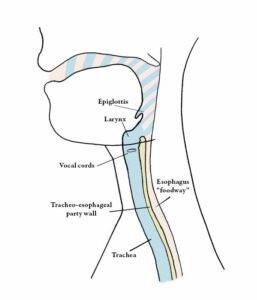Laryngeal Anatomy & Physiology
 The area we commonly call the” throat” is referred to by physicians as the upper aerodigestive tract. That’s because the upper part of the throat functions both as an airway (“aero”) and also as a food way (“digestive”). It is only at the level of the larynx that the airway and foodway separate not only functionally but also anatomically. The very first part of the dedicated airway is the larynx or voicebox. Just behind the larynx is found the cervical esophagus, which is the initial dedicated structure in the food way.
The area we commonly call the” throat” is referred to by physicians as the upper aerodigestive tract. That’s because the upper part of the throat functions both as an airway (“aero”) and also as a food way (“digestive”). It is only at the level of the larynx that the airway and foodway separate not only functionally but also anatomically. The very first part of the dedicated airway is the larynx or voicebox. Just behind the larynx is found the cervical esophagus, which is the initial dedicated structure in the food way.
The larynx or voicebox can be thought of as having a skeletal component as well as an internal soft tissue neuromuscular component. The skeleton of the voicebox is made up of thyroid cartilage, cricoid cartilage, epiglottic cartilage, and arytenoid cartilages. The vocal folds themselves live inside the larynx or voicebox.
How to See Inside the Throat
Visualization of the vocal folds is done from above, using the assistance of an endoscope. One endoscopic method uses a rigid stainless steel “periscope.” This kind of scope is passed through the mouth and its distal end hovers above the base of the tongue, looking downward into the laryngeal vestibule. A camera can be attached to this endoscope to obtain images of the vocal folds.
The other type of endoscope is a slender, flexible tube that is passed through the nose, past the upper surface of the soft palate, and then downward to again hover above the lower throat and vocal cords, looking downward.
Anatomy terms
- Directional terms:
- Anterior commissure vs. posterior commissure
- Aryepiglottic cord
- Arytenoid cartilages
- Cartilaginous glottis vs. membranous glottis
- Cricopharyngeus muscle
- Epiglottis
- Esophagus
- False vocal cord
- Glottis
- Hypopharynx
- Laryngeal ventricle
- Laryngeal vestibule
- Laryngopharynx
- Larynx
- Lower esophageal sphincter (LES)
- Mucosa
- Palate
- Posterior pharyngeal wall
- Pyriform sinus
- Recurrent laryngeal nerve
- Subglottis
- Supraglottis
- Trachea
- Tracheoesophageal party wall
- True Vocal Cords
- Uvula
- Vallecula
- Vocal process
Share this article